How To Repair Fine Cracks In Chimney
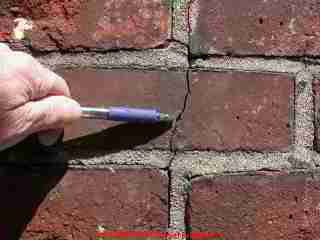 Masonry Chimney Cleft Inspection & Diagnosis
Masonry Chimney Cleft Inspection & Diagnosis
- POST a QUESTION or COMMENT about how to diagnose & repair chimney cracks
InspectAPedia tolerates no conflicts of interest. We take no relationship with advertisers, products, or services discussed at this website.
Diagnose cracks in chimneys:
This commodity catalogs the types of chimney cracks and movement that may exist found in brick, rock, or concrete block chimneys; we describe the inspection and and diagnosis of the cause of each type of chimney slap-up and we propose the probable severity, prophylactic concerns, and chimney repairs that may be necessary.
Nosotros include links to boosted detailed articles about each blazon of chimney bully or move.
Nosotros also provide an Commodity INDEX for this topic, or you tin endeavour the page top or bottom SEARCH BOX as a quick way to find data you need.
Cracked Brick Masonry Chimney Sides
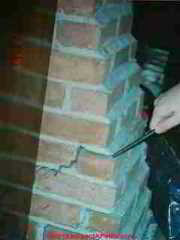 This article series on chimneys, chimney construction, and chimney safety provide detailed suggestions describing how to perform a thorough visual inspection of chimneys for rubber and other defects.
This article series on chimneys, chimney construction, and chimney safety provide detailed suggestions describing how to perform a thorough visual inspection of chimneys for rubber and other defects.
Chimney inspection methods and chimney repair methods are also discussed.
Guide to Diagnosing & Evaluating Cracks in Brick Chimneys
Our brick chimney photographs just in a higher place illustrate a common (and dangerous) fissure pattern found in corbeled (stair-stepped) chimneys where a brick chimney passes through an cranium floor and is angled over to exit at the chimney ridge.
At the chimney in our photo at to a higher place left, look very closely at the masonry articulation where the chimney begins its transition from vertical to angled.
To forbid cracks in a leaned-brick chimney such equally this 1, the chimney depends on absolutely stable back up by the roof framing structure where it passes through the roof to outside.
Unless the brick chimney was adequately supported and constructed it may lean, causing the cleft blueprint nosotros prove beneath.
Lookout man out: oftentimes the crack in a leaning brick chimney occurs at the cranium floor where the chimney begins its transition from vertical to angled - a spot where the crack may be hard to spot.
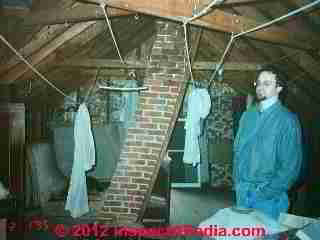
See CHIMNEY INSPECTION INDOORS for a discussion of chimney motion that opens a difficult-to-find crack where a corbeled brick chimney passes through an attic floor.
List of Typical Causes of Cracks in Brick Masonry Chimneys & Flues
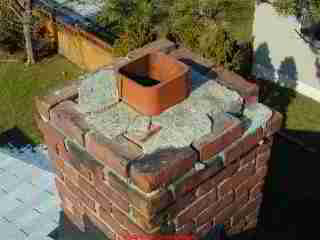 Cracks in a brick masonry chimney such every bit shown in these photographs may be caused by improper original chimney structure. This damage also appears on concrete block constructed chimneys.
Cracks in a brick masonry chimney such every bit shown in these photographs may be caused by improper original chimney structure. This damage also appears on concrete block constructed chimneys.
- Improper construction: failure to leave air space between flue line and masonry chimney sides - if the mason does not leave an expansion gap surrounding the clay flue liners as they are ready into the chimney during construction, as the flue heats up during use, the expanding flue may crack the surrounding brick.
- Water leaks: at the chimney top (missing rain cap, faulty chimney cap superlative seal), or at the chimney sides (defective flashing, wind-diddled pelting, open mortar joints) can transport water into the chimney construction where in freezing climates frost can lead to cracks to the chimney itself or to its flue liner.
We illustrate water and frost damage to a brick chimney in this article, below.
Also come across CHIMNEY CAP & CROWN DEFINITIONS
and CHIMNEY FLASHING MISTAKES & LEAKS.
And since water and frost can also crusade surface spalling of brick or concrete cake chimneys,
also see CHIMNEY SPALLING, EXTERIOR
- Chimney movement: a chimney which is set up on a defective ground or foundation (more improper chimney construction) or a chimney which was non properly secured to the building may lean, bend, or curl, leading to cracks that usually announced in the mortar joints.
See BRACING for MASONRY CHIMNEYS
- Thermal expansion cracks in chimneys: a masonry chimney may cleft from thermal expansion, or its internal flue may scissure from thermal expansion, if the chimney was not properly constructed, failing to exit space for movement as the chimney interior heats up when in use. Nosotros illustrate thermal bang-up in a brick chimney in this commodity, just below.
Also see THERMAL EXPANSION of MATERIALS for a table of the coefficient of expansion of common building materials.
- Mechanical damaged chimney slap-up: a masonry chimney may cleft due to stresses from a chimney-mounted antenna, or from earthquake or nearby site diggings stresses.
See EARTHQUAKE CHIMNEY Plummet DANGERS
The second cracked chimney at higher up right is a scrap more suspect because we see what might be traces of soot or creosote having done out through the cracks to the chimney outside. If this proves to be the instance this flue is certainly seriously damaged.
Frost Groovy in Brick Chimneys & Flues - outdoor & indoor evidence of brick chimney damage
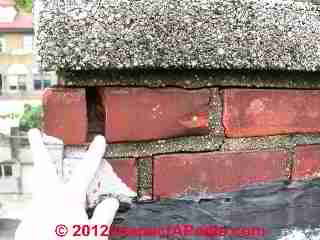
At left we show a very common fissure pattern found in brick masonry chimneys & flues - water and frost cracking at the chimney top.
Considering that at that place is a nice thick concrete chimney cap. why do nosotros accept this brick movement and mortar-articulation cracking?
Peradventure the chimney cap is croaky, flat, not draining, or it was non sealed around the flue, or a pelting cap was missing.
Run across CHIMNEY CAP & CROWN DEFINITIONS for detailed examples of defects at the chimney top that lead to this blazon of chimney harm.
Likewise meet CHIMNEY SPALLING, Exterior
At beneath left we show a very common cleft pattern found in brick masonry chimneys & flues - a collection of vertical, diagonal, and even some horizontal chimney cracks that are probably due to a combination of water intrusion and (in freezing climates) frost cracking.
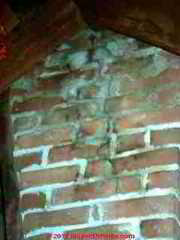
Even if y'all do not immediately notice the chimney cracks themselves you are likely to spot this chimney damage by the creosote stains carried to the chimney surface past water entry into the chimney flue.
Of form had these cracks and stains been present on a hidden side of the chimney, say betwixt the chimney and a close-by gable-stop wall, you'd not see these clues from inside the attic.
But inspecting this chimney outside, if it has had no proper rain cap and chimney cap you should be extra alert for water and frost damage to the chimney and its flue.
A 2nd fix of clues - water leak stains, may be visible in a fireplace or at a chimney cleanout lower in the edifice.
Thermal Dandy in Brick Chimneys & Flues May Produce Thin Vertical Openings

At left we show a very common fissure pattern constitute in brick masonry chimneys & flues - a vertical crack that begins in a mortar articulation and extends through individual bricks themselves.
Cracked chimney masonry such as shown in the photo of cracks in a brick chimney outside (at left), may a prophylactic concern if the flue liner or chimney are not intact and fire/gas safe.
The brick chimney crack type shown hither is more frequently caused by thermal expansion (and improper chimney construction) than by frost - frost cracking is ofttimes more visually obvious and is oft accompanied by brick spalling.
Astringent Chimney Swell - Deteriorated, Collapsing Brick or Masonry Block Chimneys
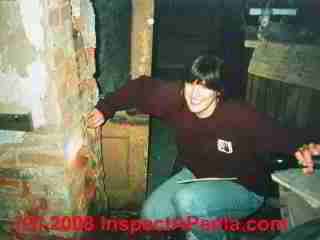 Severe chimney cracks that take a chance imminent chimney collapse, flue gas leaks, and fire hazards, are discussed and illustrated in detail
Severe chimney cracks that take a chance imminent chimney collapse, flue gas leaks, and fire hazards, are discussed and illustrated in detail
at BRICK CHIMNEY CRACKS & Collapse
In that location nosotros besides describe a case of an imminent catastrophic chimney collapse
Likewise come across our give-and-take
of Concrete BLOCK CHIMNEY CRACKS
Lookout man out: Cracks in a chimney can be very meaning and dangerous, risking fire or chimney collapse.
Be sure to review the dangerous chimney collapse warnings at
at CHIMNEY Plummet RISKS, REPAIRS
Cracks in Masonry Block or Physical Block Chimneys
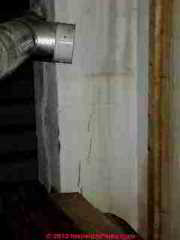
Cracks in a masonry chimney, particularly concrete block chimneys are often caused by
- chimney footing tipping or settlement (inadequate foundation)\
- frost (poor drainage, missing pelting cap, porous masonry, improper construction in freezing climates)
- thermal expansion of the clay flue liner (improper construction)
- mechanical damage,
- or perchance other events
Run across Croaky CHIMNEYS, MASONRY Block for details and additional photographs of concrete block chimney cracking.
Chimney Cracks due to Chimney Motility, Tipping, Leaning
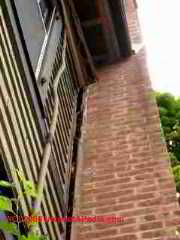
Chimneys that lean, curve, bulge, tip, or otherwise move due to footing settlement and tipping or due to failure to secure a tall chimney to the edifice also may produce both visible cracks on the chimney exterior and hidden cracks and damage to the chimney flue.
The hazard of an unsafe chimney flue lies behind our communication that a thorough inspection of the entire chimney flue is necessary when there is any bear witness of chimney motion.
Run into CHIMNEY INSPECTION from Ground for details of the detection, analysis, and repair of leaning and tipping chimneys and chimneys that take separated from their edifice.
Curved Brick Masonry Chimneys
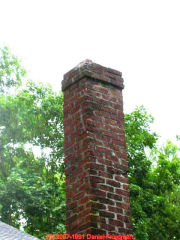
Especially on older buildings using brick chimneys, and more so where the chimney flue is non lined with a modern clay liner, brick chimneys may be seen to curve in one direction.
Often all of the like chimneys in a neighborhood bend in the same direction. It's non a coincidence. A brick chimney will frequently curve away from its most weather-exposed side due to sulphation - expanding brick mortar joints acquired by the combination of water and sulphur or other minerals.
See CURVED BRICK CHIMNEYS, SULPHATION for farther caption of the cause, significance, and cure of curved brick chimneys.
Reader Q&A - also run across the FAQs series linked-to beneath
It certainly sounds equally if it's worth having a more thorough chimney inspection for cracks and damage that are sending water down through the chimney flue, structure, or other openings such that it leaks into your floor and is dissentious the floor. See if you can find a chimney sweep who has a Chim browse camera.
About ten years ago my chimney was hit by lightning and blew the exposed peak completely off the house. I had a chimney repair person install new top and fill whatever cracks on the fireplace caused by the strike. In time i noticed the laminate flooring was separating.
A couple of ceiling leaks, the subflooring in my family room was bouncy . Other electric was damaged such equally furnace washer dryer etc. I was just wandering has anyone else had this feel this problem.
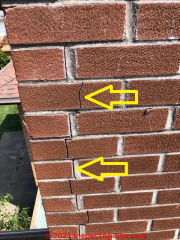 Joe:
Joe:
Lightning strikes tin can vaporize moisture and crusade all sorts of crazy harm, including slap-up masonry chimneys, fifty-fifty slabs and buildings;
but I can't say a thing conclusively from just your photo.
Frost impairment, wet harm, and in long brick walls, thermal expansion can also crusade vertical and stepped cracks.
I doubtable your harm may be from frost. (In what climate is this chimney located?)
Examine the opposite finish of the same wall and the other building corners and bear witness me if those have cracks.
Hey I was just wondering if it was possible that lightning could take caused this damage?
What is the proper procedure for applying stucco over a chimney that hass moss in mortor joints
Looks like moisture behind the veneer or poor connections of veneer to the structure behind information technology or, movement in the supporting structure itself.
A better installation would take included a pinnacle crown (that sparse concrete wash atop the chimney) that extended out an inch or so past the vertical surfaces of the veneer walls and then as to be certain nosotros're not leaking water into the chimney chase.
Also I can't come across the chimney flashing- I suspect the veneer was installed over the flashing or counter flashing; simply we can't see just what was present - so be sure to check the roof interior below this area for leaks.
An ugly repair might be silicone in those cracks merely I'thou doubtful; if you lot button on the veneer does information technology move? That'd exist diagnostic.
Probably the only real repair is to tear all of this off, audit and if necessary fix the supporting construction, fix any flashing errors, install new veneer properly secured, install a proper pinnacle crown, reinstall elevation chimney cap
These were done 8 months agone. They reframed and re bricked (sparse veneer bricks not typical size bricks) The cracks are similar to what happened to chimneys that were there for 25 years. The cracks are mainly at the corners. Whatsoever help would exist appreciated.
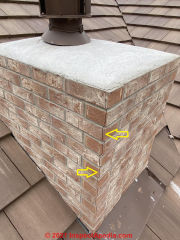
Miss J
No, sorry merely nosotros cannot offer to repair the damage to your chimney. InspectAPedia.com provides building and environmental diagnostic and repair data. In society to admittedly assure our readers that we write and report without bias we do non sell any products nor services, nor do we take any business or fiscal relationships that could create such conflicts of interest.
But nosotros tin offering advice, propose questions to enquire, and assist you lot sort through most building and environmental problems.
I would start by hiring a professional certified chimney sweep or repair company and I would have them inspect the entire chimney flue. We don't know if the harm is little, confined to a to clay flue tile liner (remove and replace) or if at that place is more extensive damage that makes the flue unsafe.
Let me know what you're told, post photos (one per comment, as many comments as you need), and we can take it from at that place.
InspectAPedia is an independent publisher of building, environmental, and forensic inspection, diagnosis, and repair information for the public - we accept no business nor fiscal connexion with any manufacturer or service provider discussed at our website. Nosotros very much welcome critique, questions, or content suggestions for our web articles.
More about united states of america is at Nearly InspectApedia.com https://inspectapedia.com/Admin/About_InspectApedia.php
I thought my roof was leaking so I phoned the company I already had work done by. After their Roofer looked at information technology he told reassured me my roof was not leaking .
I saw him taking photos and asked if I had rain coming down my Chimney. I replied aye. He took more photos. So came down of the roof. On this he shown me a scissure in the chimney stack.
I was wondering if you could give me a reasonable quote to have this trouble resolved every bit I am a oap. Yours sincerely Miss J Thurston. Cheers very much. I look forward to hearing from y'all.
Adept said it was likely due to shifting, but only looked at emailed photos. Quoted 2600 USD to tear down to roof level.
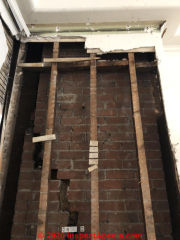 There are 2 serious safety hazards hither
There are 2 serious safety hazards hither
Scout out: A chimney collapse, injuring someone nearby and dissentious the building,
And
Watch out: in that location is a near-certain risk of fatal carbon monoxide poisoning or a building fire if the chimney in use.
1. Rope off the area and keep poeople abroad pending an onsite expert'south assistance
two. Brand certain no oil or gas or other fueled equipment is using the chimney.
One would need to inspect the whole chimney downward to its ground to understand the exact cause, but well-nigh certainly this chimney is across economic repair. It needs to exist removed and replaced.
I take a chimney that cracked badly and seperated from the wall. information technology was due to pile driving backside our building. it is very hard to tell what is happening with the chimney or how it was attached to the building. it looks as though information technology detached from one side of the wall and is pushing the other side. i can see into the chimney , oddly plenty the chimney crack stops on the inside and doesn't travel to the outer chimney, information technology is inside of my building then I dont accept whatsoever thought how to take it down. can i exit it alone, every bit it seams like such a massive projection that i dont think nosotros tin afford to have it removed. ( probbaly cant afford not to have it removed.) I have had contractors say it might fall down. does the outside chimney connect with the inside chimney ? can they exist two serperate structures? or are they synthetic all in one structure? information technology is so massive i am affraid to touch it anywhere. I accept tried to pull the sheetrock abroad from the structure. unfortunately alot of the edifice has decorative moldings, and paneling .. It looks like the chimney is pushing on 1 side of the wall due to cracks forth the wall. i have had no water come up in but i can see daylight, into the chimney. its bad
Please allow me know what you are told.
I should accept clarified that "leaking" was more than of a staining. It'southward not as if it's pooling or a serious issue at all; just evidence that in that location is/was h2o.
Because this is more complicated than I idea information technology would, I'm going to have it looked at (in person!) past a professional.
Thanks for all your help.
It would exist worth looking carefully at the chimney to exist sure we know where the water is entering. E.g. h2o tin can enter at the top from a missing rain cap or missing elevation or crown seal, run downward betwixt the flue and the cake or masonry of the chimney, and cause frost harm.
The right pattern does suggest water coming in from the pinnacle or somewhere on the chimney height to a higher place ground. Feeling the top is reasonable if you tin can admittedly prevent the chimney from being used in the future..
I would want to be sure that I don't have a problem with ground h2o leaking into the chimney base considering if we don't prepare that will go on to have h2o entry in the basement. Let's resolve the H2o Source question start
Thanks for the quick response. Yes I'k in a freezing climate in Ontario, Canada.
It's not continued to a fireplace, it really never volition be used once more. It was used past an oil furnace which has since been replaced for natural gas. The opening into the basement to which it connects was "sealed" but is leaking dirty water, so yes water seems to be an issue.
Would you suggest sealing the flue at the top? I've seen online tutorials using sheet metallic and silicone caulk. If I exercise that, should I not seal the basement opening?
I'yard besides considering having the chimney removed to play it safe.
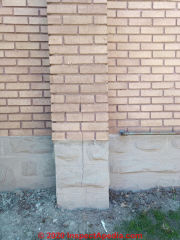 Yard
Yard
I am in no position, here far abroad and with only i photograph, to argue with whomever your onsite expert was. Weight might crusade masonry to separate in the middle, simply so might frost from h2o running within the masonry chimney, mayhap from a bad peak seal, crown, or missing cap.
Are you in a freezing climate? If non we'll rule that explanation out.
Chimneys do not normally split up from their ain weight.
A bad or settling chimney footing under a masonry chimney can crusade not bad but I think the cracks would be different in location and blueprint.
Likewise, that, the most-important bespeak is this:
Watch out: the serious risk is of an dangerous chimney flue, risking burn down or fatal carbon monoxide hazards. Yous should accept the flue inspected past a certified chimney sweep - for safety - before continuing to use this flue. That inspection tin give us an thought well-nigh what repair is most-appropriate.
Let me know what you're told and I tin can offer some further suggestions.
I have this crevice from the base on an unused chimney stack, I've been told that it's considering of the weight of the chimney and that it's sticking out from the firm. Thoughts?
Mayra
In your photo I encounter fine hairline cracks right through the center of what looks similar bricks - in a brick and mortar masonry chimney.
I take so little information that I can only gauge that the bricks may take cracked from thermal changes in the chimney or peradventure fifty-fifty overheating.
Y'all would be wise and safer to have the chimney inspected by a certified chimney sweep (National Chimney Sweeps Guild if you are in the U.South.)
not but for the crack nosotros see, merely to assure that the interior flue is intact and safe.
IF the chimney is indeed significantly damaged it may be repairable by re-lining, but gee that's just speculation from a very limited image.
I am interested in buying a house. However, I am concern considering the chimney has many cracks. What could the cause of such cracks be?
Epitome LOST by older version of Clark Van Oyen'south useful Comments code - now fixed. Delight re-post the epitome if you can. Distressing. Mod.
Question:
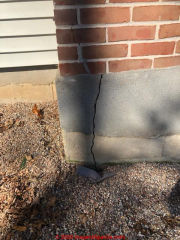 (November 4, 2022) DP said:
(November 4, 2022) DP said:
Hi,
Recently noticed this crack along my chimy. We've lived here nearly a year and not sure if this was there when we moved and we (along with inspection) missed information technology or its new.
Any suggestions?
Measured it and its between ane/8 and 1/sixteen of an inch wide.
Thank you in accelerate!
This Q&A were posted originally at CONSULTANTS & EXPERTS DIRECTORIES
Moderator reply:
DP:
We need more than details to make even a wild guess at cause, impact, & repair of this chimney foundation crack;
I concord that it's big plenty to warrant investigation and at the very least, sealang, perhaps other repair.
On the other hand, I don't encounter cracks extending up from the physical base into the body of the chimney.
Watch out: the start condom question that occurs to united states is the risk of a croaky, damaged chimney flue - risking fire or fatal CO poisoning. And so you might start by request a certified chimney sweep fdor a thorough inspection of the chimney flue for condom.
Some additional diagnostic questions:
- Does this dwelling house take a basement?
- How old is the home.
- What are the state and city of location?
- In the basement is at that place heating equipment venting into this chimney?
- In the basement is there a chimney cleanout admission opening? If so open it and look for signs of water entry and also - of import - tell me if the bottom of the cleanout chamber is at the aforementioned level as the basement floor slab or college.
...
Go along reading at CRACKED CHIMNEYS, MASONRY BLOCK or select a topic from the closely-related articles below, or see the complete Article INDEX.
Or see CHIMNEY CRACK DETECTION & DIAGNOSIS FAQs - questions & answers posted originally on this folio.
Or see these
Chimney Collapse / Crevice Articles
- CHIMNEY Plummet RISKS, REPAIRS
- CHIMNEY CRACK DETECTION & DIAGNOSIS
- BRACING for MASONRY CHIMNEYS
- BRICK CHIMNEY CRACKS & COLLAPSE
- CHIMNEY Plummet RISKS, REPAIRS
- CHIMNEY DAMAGE by LEAKS & FROST
- CHIMNEY FLUE INSPECTION Camera
- CHIMNEY FOOTING Lacking / MISSING
- CHIMNEY INSPECTION DIAGNOSIS REPAIR - home
- CHIMNEY INSPECTION INDOORS
- CHIMNEY INSPECTION OUTDOORS
- CHIMNEY INSPECTION from GROUND
- Physical BLOCK CHIMNEY CRACKS
- CURVED BRICK CHIMNEYS, SULPHATION
- Earthquake CHIMNEY COLLAPSE DANGERS
- SPLIT OPENINGS in BRICKS, CHIMNEY COLLAPSE
- CHIMNEY Impairment by LEAKS & FROST
- SOIL PROPERTIES & Edifice FAILURES
Suggested commendation for this web folio
CHIMNEY Crack DETECTION & DIAGNOSIS at InspectApedia.com - online encyclopedia of building & environmental inspection, testing, diagnosis, repair, & problem prevention advice.
Or see this
Alphabetize to RELATED Articles: Commodity INDEX to CHIMNEYS & FLUES
Or use the SEARCH BOX found below to Ask a Question or Search InspectApedia
...
Inquire a Question or Search InspectApedia
Effort the search box just below, or if you adopt, post a question or comment in the Comments box below and we will respond promptly.
Search the InspectApedia website
Annotation: appearance of your Comment below may exist delayed: if your annotate contains an prototype, spider web link, or text that looks to the software equally if it might be a web link, your posting volition announced after information technology has been canonical past a moderator. Apologies for the delay.
Technical Reviewers & References
Click to Bear witness or Hide Citations & References
Publisher InspectApedia.com - Daniel Friedman
Source: https://inspectapedia.com/chimneys/Chimney_Crack_Diagnosis.php
Posted by: holmquistproaderescid41.blogspot.com


0 Response to "How To Repair Fine Cracks In Chimney"
Post a Comment